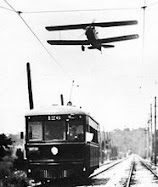“I am coming, I am coming! Hark you hear my motors humming? For the trolley’s come to conquer and you cannot keep it back;And Zip! The sparks are flashing as the car goes onward dashing;Yes the trolley’s come and conquered so look out and clear the track!”
Thus did a late 19Th century author describe the advent of the electric streetcar, an event that literally changed the way Americans went to work and play and moved about the cities. Jacksonville boasted one, then two, four, six or more fairly large streetcar companies, all of which eventually folded into the operations of The Jacksonville Traction Company. Today we are faced with another major change in individual mobility, $4-a-gallon gasoline is causing JTA, and many other Americans to rethink the way they get around and to look more to public transit to fill the void.
As an industry that is historically underfunded and equipment-hungry, many operators are struggling to meet the demand. How does a small transit operator with a fleet of vintage electric streetcar equipment rise to meet this challenge? In the case of McKinney Avenue Transit Authority (MATA) in Dallas, Texas, a $1-3 million dollar a mile, mostly volunteer organization, we decided to examine just what it was that it did, and who it was. The answers enabled them to reaffirm their identity as a vintage operator, while plotting a course to meet the demands and expectations of new customers and take advantage of 21st century technologies.
Throughout the past year as we have seen gasoline prices spiral upward and McKinney Avenue also noticed steady ridership increases during the regular commute times. Ridership for 2008 is up 20 percent over the same period last year. In particular, they have seen a large increase in the number of passengers transferring to the streetcars from light rail stations of the regional transit authority (DART). These numbers, taken in conjunction with on-car surveys, told MATA that they were experiencing a basic change in their ridership demographics. Dallas took a hard look at what the commuter passengers expected their streetcar system to do for them.
Early in the year it was decided to air condition the fleet of vintage streetcars. A grant from the Sue Pope Foundation enabled MATA to begin addressing this issue, and in May the first air-conditioned 1920 Birney safety car in the world rolled out of the shops to the delight of our riding public. Four other cars will follow during the course of the summer, and the further addition of AC traction motors, solid-state controllers and resilient wheels over the next two years will enable them to increase safe operating speeds, decrease headways and provide a higher level of comfort and service to the riding public while maintaining the ambiance and look of the antique cars. The ambiance alone merits note, as completely missing from the scene are the large expanses of wood stained plywood seen on the faux trolley's of Jacksonville. This is REAL craftsmanship, wood and stained glass, velvet, and brass, tongue and grove perfection and vintage wavy glass windows.
A recent trip on the large "Turtle-Back" Streetcar in Dallas, with it's fancy RV style AC unit running full tilt, was proof of the success. The car was comfortable, and roomy, there was no loud noise, no bang or clatter, just the hum of the motors beneath the floor and the air compressors tale-tale thump-thump-thump when we paused. The streetcar is right in the flow of traffic in a Dallas equal of San Marco, Springfield or Riverside. The major developers have stampeded to the fixed route transit and converted the old brick warehouse and shanty town into an upscale marvel of reclaimed buildings and life. Something we so desperately need in Jacksonville.
Greenhouse gases, NOC emissions, global warming and, on a more visceral level, the cost of gas at the pump has caused Americans to re-ask the question of the World War II generation, “Is this trip really necessary?” It should cause each of us, as Jacksonville citizens, to ask some important questions about what kind of transit we want and how our various City and State agency's, can re-equip ourselves to do the job ahead of us.
Roll up your sleeves folks, it’s a big job and there’s work to do! We Must have rail to compete and perhaps to survive.




























